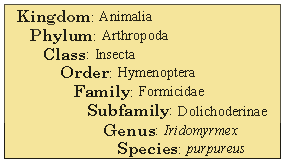Classification of Ants
Classification is used to group together plants and animals which are closely related. This helps to organise our knowledge of the great diversity of living things. The system used in biology is composed of a hierarchical or nested set of categories, starting with the broad, general groupings and progressing through a series of categories to the smallest group, a single species. The highest group is the Kingdom and all animals belong to the same kingdom, Animalia. Below kingdom is Phylum, followed by Class, then Order, Family, Genus and finally Species. For example the common meat ant would have the following classification:
In addition to these major categories, several additional categories are used which lie between them. The more important of these include Subfamily, Tribe, Subgenus and Subspecies. All ants belong to a single family, Formicidae. Within the ants, only three categories are commonly used, subfamily, genus and species. Subfamily is the largest grouping, and determining which subfamily a specimen belongs to is the first step in any identification.
There are 21 living subfamilies world-wide (see list at right), with 13 of these occurring in Australia. Of these 13 subfamilies, six (Dolichoderinae, Ectatomminae, Formicinae, Myrmeciinae, Myrmicinae and Ponerinae) are very common and are encountered regularly in most areas. The remaining subfamilies vary from fairly common in areas were they occur to very rare and seldom seen. Most ants can be placed to subfamily with little difficulty, and with practice the subfamily key can be bypassed so that identification of most specimens will begin with keys to genera.
The category below subfamily is genus. (Tribe is between subfamily and genus but is only used in selected groups.) There are about 300 genera of ants world-wide. The genus is the fundamental identification unit in ants and most ants can be identified to genus with minimal difficulty (especially when compared with species-level identifications). Additionally, much of the current information about Australian ants is of a general nature and is applicable to most members of a genus. Thus identifying ants to genus-level is a manageable task which will provide considerable information on the biology and ecology of the specimen. The names of genera are always printed in italics or are underlined when hand written.
The final level of classification is the species. To reliably determine the species identity of a specimen either a recent, detailed taxonomic revision is necessary, or reliably determined material must be available for comparison. In many cases species can be determined only by sending specimens to one of the larger collections so direct comparisons can be made with previously determined material. However, even in these cases the identification of many species will be very difficult or impossible because most groups of Australian ants have yet to be studied in detail.
As with generic names, the names of species are always printed in italics or are underlined when hand written. In addition, the name of the person originally describing the species is also included and sometimes the year in which the species was described as well. For example, the name of the common meat ant of south-eastern Australia is Iridomyrmex purpureus (Smith) or Iridomyrmex purpureus (Smith, 1858), where Iridomyrmex is the genus or generic name, purpureus the species or specific name, Smith the author of this name and 1858 the year the name was published. In this particular case Smith’s name is placed in parentheses to indicate that his species is no longer in the same genus that he originally described it in. This is because Smith had places his species in the genus Formica (as Formica purpurea Smith) and it was subsequently moved to the genus Iridomyrmex.
| ||||||||||||||||||||||||||||||||||||||||
